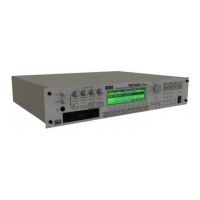252
AMP
This section contains two amps. The signal that is input to
each will depend on the filter routing. In addition, the amp
section provides an amp envelope generator (Amp EG) that
can be used to control it.
These parameters are set in PROG 5.1: Ed-Amp.
FX (effects)
This section applies effects to the signal that is output from
the amp. It has the same parameter structure as for the pro-
grams of other banks.
These parameters are set in PROG 7.1: Ed-BUS, PROG 7.2:
Ed-InsertFX, and PROG 7.3: Ed-MasterFX.
LFO
This section provides four LFO units. These LFOs can be
used as modulation sources for various parameters, apply-
ing cyclic change to the sound.
These parameters are set in PROG 5.3: Ed-LFOs.
EG
This section provides four general-purpose envelope gener-
ator (EG) units. The four EGs can be used as modulation
sources for various parameters, applying time-variant
change to the sound.
These parameters are set in PROG 5.2: Ed-EGs.
Arpeggiator
The arpeggiator can be used in the same way as for other
program banks.
These parameters are set in PROG 6.1: Ed-Arp.
Program basic
Here you can make settings for scale, key assign, and con-
troller functions (REALTIME CONTROL knobs, SW1, SW2).
These parameters are set in PROG 2.1: Ed-Basic, PROG 2.2:
Ed-Ctrl.
About the oscillators
For bank I-F, you can select from thirteen different oscillator
types for Oscillator 1, and from nine different types for
Oscillator 2.
In the PROG 2.1: Ed-Basic, Prog Basic page or OSC Basic
page, you can select the type for Oscillators 1 and 2, and use
them together.
If you have selected a Single Size oscillator type (Standard–
E. Piano Model) for Oscillator 1, you will also be able to
select a Standard–E. Piano Model oscillator for Oscillator 2.
However, Oscillator 2 cannot be used if a Double Size oscil-
lator type (Brass Model–Bowed String Model) is selected for
Oscillator 1.
Standard
This simulates the oscillator of an analog synthesizer. You
can obtain the same effects as on an analog synthesizer, such
as using PWM (pulse width modulation). (☞p.258, “EXB-
MOSS owner’s manual” p.14)
Comb Filter
This oscillator produces pitched frequency components
from noise or an impulse. It can be used to generate a
diverse array of sounds, ranging from noisy sounds to synth
bass or string-like sounds. (☞p.259, “EXB-MOSS owner’s
manual” p.17)
VPM (Variable Phase Modulation)
This oscillator uses phase modulation to generate overtones.
You can produce rich overtones by using phase modulation
between two oscillators and a wave shaping table to process
the sound. (☞p.259, “EXB-MOSS owner’s manual” p.18)
Resonance
This oscillator is an application of filter oscillation, and is
especially good for mallet sounds or pads. (☞p.260, “EXB-
MOSS owner’s manual” p.20)
Ring Modulation
Cross Modulation
Sync Modulation
These are special oscillators that implement the modulation
between oscillators that could be created on analog synthe-
sizers. They are suitable for producing sounds with rich
overtone structures, such as bells, metallic sounds, and
gongs. (☞p.260–261, “EXB-MOSS owner’s manual” p.21–23)
Organ Model
This uses one oscillator to simulate an organ with three
drawbars, or two oscillators to simulate an organ with six
drawbars
Since a single drawbar can generate one of four waveforms
that you choose, you can obtain a wide range of tones.
(☞p.261, “EXB-MOSS owner’s manual” p.23)
E. Piano Model (electric piano model)
This is a physical model that simulates a warm vintage
piano sound. (☞p.261, “EXB-MOSS owner’s manual” p.24)
Brass Model
This is a physical model that simulates a brass instrument
such as a trumpet or trombone. (☞p.262, “EXB-MOSS
owner’s manual” p.25)
Reed Model
This is a physical model that simulates a wind instrument
such as a sax or flute. (☞p.262, “EXB-MOSS owner’s man-
ual” p.27)
Plucked String Model
This is a physical model that simulates a plucked string
instrument such as a guitar or bass guitar. (☞p.263, “EXB-
MOSS owner’s manual” p.29)
Bowed String Model
This is a physical model that simulates a bowed string.
(☞p.263, “EXB-MOSS owner’s manual” p.31)
Loading the preloaded data
Load the data from the “MOSS00FD” floppy disk included
with the EXB-MOSS.
The floppy disk contains the following data.
MOSS.PCG
MOSS.SNG
Cue List
Song (TRITON, TRITON Pro, TRITON ProX song file)
“Feet Hurt MOSS” by Scott Frankfurt
©1999 Bleach Bros. Music (breachbros@earthlink.net) – all
rights reserved
Programs Bank I-A, I-B, I-C, I-D, I-F
Combinations Bank I-A, I-B, I-C, I-D
Drum Kits 00–15 (I-A/B)
Arpeggio Pattern 000–199 (I-A/B)
Global Settings

